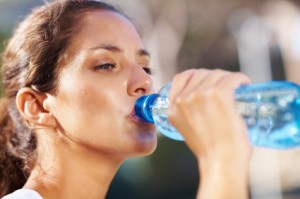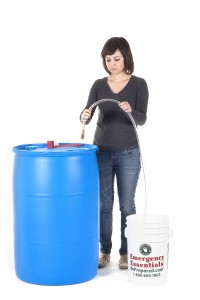
Every cell in our bodies contains water, and we need a constant supply to stay alive and healthy. We can do without food for a surprising period of time if we must, but we survive only a few days—3 to 4 in hot weather—without water. When we are dehydrated, our kidneys begin to shut down, our heart races, our body temperature rises, and our electrolytes get out of balance, causing fuzzy vision and thinking (making it even harder to Replace sources of water).
How much water do we need to store?
Whatever kind of emergency arises, we soon realize that clean, drinkable water is the most important substance we need. At least one gallon per person per day is recommended—not only for drinking, but for cooking and hygiene. It’s wise to store at least two weeks’ worth (14 gallons) for each person in your household.
What kind of containers are best?
Water is heavy—8 lbs. per gallon. It’s great to have a couple of
55-gallon barrels for sheltering in place—but once filled, they can’t be moved. If you had time in an emergency situation, you could siphon some of that water into 1 or 5-gallon containers to take with you. We suggest, however, that you store some water in small, portable containers that you can grab and go in case of an evacuation order. Keep some in your car for unforeseen situations. Here is a list of the types of containers that work best for water storage:
Small Containers
-
You can purchase water in small boxes—AquaBlox or Datrex metallized (Mylar-type) pouches for total convenience.

- Be sure that whatever containers you choose are BPA-free, Polyethylene-based plastics or those numbered #1, #2, or #4, or “Mylar” are safe for water storage. It is true, however, that plastic is porous (even though it doesn't appear to be), and eventually allows the water to absorb odors and tastes from the environment. Because of this permeability factor, we do not recommend using plastic milk bottles or similar bottled-water plastic gallon jugs for long-term water storage. Another reason is that they usually allow light through, and light encourages growth of any microorganisms that might be present. It’s difficult to get all bacteria out of a milk jug, for example.
-
For your personal water bottle that you carry with you, be sure it also is BPA-free. If it’s marked with a #1, “PETE,” or “PET,” it should be fine.
Water Barrels and Combos
-
Large, shelter-in-place storage containers start with the 160-gallon reserve. It is made from an enhanced plastic which is BPA-free, UV resistant, and non-permeable, and which has a faucet for easy access. These can be stacked two-high.
-
Our water barrels (55-gallon, 30-gallon, and 15-gallon) are made from thick, durable food-grade plastic, blue in color to limit light-exposure and discourage bacterial and algae growth.
-
You will need a siphon and a bung wrench to fill and access these barrels. For both the barrels and the 160-gallon reserve, it’s advisable to place them on a wooden pallet rather than a cement floor, and away from sunlight.

Portable water containers and Aqua pods
-
Several other portable water containers are available as well, including 5-gallon Mylar-type bags which are good for short or long-term storage, and jugs with handles and spouts which are useful in case you must carry water from your large container to your kitchen or fetch water home from another source such as an emergency relief truck.
-
A unique, temporary water storage device is the AquaPod Kit—a giant bladder that fits into your bathtub and holds 65 gallons of clean water. This is excellent when a hurricane is threatening, or when you know ahead of time that your water supply is going to be cut off a while for repairs.
How long does water keep?
Since water (unlike food) does not “go bad” or expire, you can safely store it for an indefinite period of time in clean, appropriate containers. It can, however, become contaminated if chemicals or microorganisms get in, so there are ways to treat and purify it—see our next blog on that subject! If it makes you feel better, you can rotate your water supply every year or two to be sure it’s still good. Any “stale” taste in stored water can be quickly overcome by pouring some back and forth between glasses or pitchers to re-introduce oxygen into it.
However you choose to store water, it’s a gift to your present peace-of-mind as well as a protection against possible dehydration—and in any emergency situation in which your water supply was disrupted or contaminated, you and your family would be very glad for your foresight!



